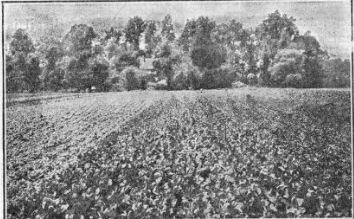Beet (Beta Vulgaris)
Description
This section is from the book "Vegetable Gardening", by Ralph L. Watts. Also available from Amazon: Vegetable Gardening.
Beet (Beta Vulgaris)
318. History And Importance
The plant from which the various types of beets have been originated is native to the sea coast of South Europe. Cultivated forms have been grown for more than two thousand years. The beet is an important vegetable in European countries and is largely grown in America, where soil and climatic conditions are suitable. The vegetable is especially valuable to market gardeners who follow the most intensive systems of cropping. (See Figure 63.) The fleshy leaves of the garden type are used extensively for greens and the roots are valued for pickling or for cooking.
319. Soil
There are very few American gardens in which beets are not grown to some extent for the home table. While this is true, certain soil characteristics are essential when the enterprise is to be undertaken on a large commercial scale, especially when the product is to be sold on an open market in competition with beets grown under ideal conditions.
Although oval and turnip-shaped beets are shallow feeders, a fairly deep, moist, but well-drained soil is apparently necessary for all varieties. The sandy loams are best suited for this crop, especially when earliness is an important factor. When grown in heavy soils the beets besides being unsymmetrical in form, develop a large number of fibrous laterals, objectionable from both market and culinary standpoints. Clover sods, green manures and stable manures greatly improve the physical condition of heavy soils, but in such soils beets cannot be expected to produce as fine roots as in soils better adapted to them. Favorable market conditions, however, may make the crop remunerative under adverse soil conditions.

Fig. 63. field of garden beets.
320. Climatic Requirements
The beet thrives best in the cooler parts of the country; hence the crop is more important in the North than in the South. When planted southward, advantage is taken of the moderate temperatures of early spring. Although the plants are comparatively hardy, frost sometimes injures or even kills the very early plantings and the crop must be harvested and protected before severe freezing weather in the fall.
Continue to:
Tags
plants, crops, gardening, cultivated, harvesting, food ,greenhouses, fertiliser, vegitables
